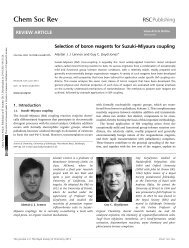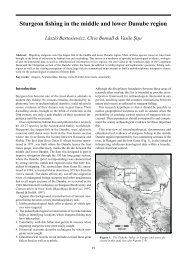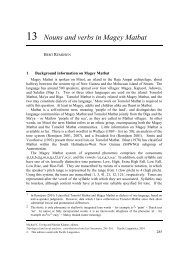Retistruct: Reconstruction of Flat-mount <strong>Retina</strong>eet al. [3]. The binocular field starts a few degrees below <strong>the</strong>horizon <strong>and</strong> continues well behind <strong>the</strong> animal’s head – very like<strong>the</strong> situation in <strong>the</strong> rabbit [23].Eye muscles <strong>and</strong> S-opsin in retinal <strong>and</strong> visuotopiccoordinatesTo examine <strong>the</strong> orientation of <strong>the</strong> eye, <strong>the</strong> locations of <strong>the</strong>insertions of superior, lateral <strong>and</strong> inferior rectus into <strong>the</strong> globe of<strong>the</strong> eye were marked onto <strong>the</strong> retina (Figure 7A; see SupplementalMaterials <strong>and</strong> Methods, Text S1, <strong>for</strong> procedure). The nasal pole of<strong>the</strong> retinae is determined with reference to <strong>the</strong> nictitatingmembrane. The retinae were reconstructed <strong>and</strong> plotted in anazimuthal equidistant polar projection <strong>and</strong> <strong>the</strong> vectors connecting<strong>the</strong> insertion points <strong>and</strong> <strong>the</strong> optic disc were plotted (Figure 7B).Once in a st<strong>and</strong>ard space, <strong>the</strong> muscle insertion points (n~33) fromall <strong>the</strong> retinae (n~17) were plotted in <strong>the</strong> same plot <strong>and</strong> <strong>the</strong>vectors connecting <strong>the</strong> Karcher mean of each muscle insertion <strong>and</strong><strong>the</strong> Karcher mean <strong>for</strong> <strong>the</strong> optic disc location were plotted(Figure 7C). Figure 7D shows <strong>the</strong> mean vector angles: lateralrectus, at 184.963.6u, is directly opposite <strong>the</strong> nasal cut, superiorrectus is at 91.365.9u <strong>and</strong> inferior rectus is at 284.264.1u,wherenasal is 0u. It is noticeable that <strong>the</strong>re is considerable variability in<strong>the</strong> locations of <strong>the</strong> muscle insertions, certainly when compared to<strong>the</strong> variability of <strong>the</strong> optic discs. A considerable contributory factorin this is <strong>the</strong> large extent of <strong>the</strong> muscle <strong>and</strong> <strong>the</strong> relative difficulty indetermining <strong>the</strong> centre of <strong>the</strong> muscle.The location of <strong>the</strong> optic axis at 64u azimuth <strong>and</strong> 22u elevation[15] determines <strong>the</strong> location of <strong>the</strong> vertical <strong>and</strong> horizontalmeridians on <strong>the</strong> eye. The location of <strong>the</strong> ipsilateral decussationline confirms this azimuthal value (Figures 5E & 6C). As <strong>the</strong> mouseretina has no pronounced horizontal streak, we looked at <strong>the</strong>distribution of short wavelength opsin (S-opsin) in <strong>the</strong> retina.Haverkamp et al. [24] describe a very distinct distribution patternin <strong>the</strong> retina, with high density ventral, low density dorsal <strong>and</strong> anabrupt transition <strong>and</strong> suggested that <strong>the</strong> transition coincided with<strong>the</strong> horizontal meridian. Figure 8A shows immuno-staining <strong>for</strong> S-opsin from dorsal, central <strong>and</strong> ventral retina. The densitydifference between dorsal <strong>and</strong> ventral is marked <strong>and</strong> <strong>the</strong> transitionis abrupt. Figure 8B & 8C illustrate <strong>the</strong> trans<strong>for</strong>mation of <strong>the</strong> S-opsin distribution from retinal flat-mounts to st<strong>and</strong>ard retinalspace to an orthographic representation of visuotopic spacecentred on <strong>the</strong> optic axis. In <strong>the</strong>se plots, <strong>the</strong> transition is3.360.3u above <strong>the</strong> horizontal meridian at <strong>the</strong> level of <strong>the</strong> opticaxis <strong>and</strong> is tilted by 13.863.6u, so that transition is 7.862.0u above<strong>the</strong> horizontal meridian in central visual field <strong>and</strong> 6.061.6u below<strong>the</strong> horizontal meridian peripherally (Figure 8D). The label fromboth left <strong>and</strong> right retinae was also plotted in a sinusoidalprojection (Figure 8D) to illustrate that <strong>the</strong> rotation seen in <strong>the</strong>orthogonal plots <strong>for</strong> each eye is symmetric along <strong>the</strong> verticalmeridian of <strong>the</strong> entire visual field (Figure 8E).In summary, with <strong>the</strong> location of <strong>the</strong> optic axis determined by<strong>the</strong> optimal match of <strong>the</strong> decussation line with <strong>the</strong> verticalmeridian, <strong>the</strong> change in S-opsin staining nicely coincides with <strong>the</strong>horizontal meridian, at least <strong>for</strong> <strong>the</strong> central visual field, aspredicted by Szél et al. [25]. It is worth noting that S-opsin ismostly co-expressed with medium wavelength opsin (M-opsin)[24,26], <strong>and</strong> that this would make <strong>the</strong>se cones in upper visual fieldrespond to a broader spectrum, which may have implications <strong>for</strong><strong>the</strong> ability to detect a larger range of objects above <strong>the</strong> mouse. Theprecise distribution of S-opsin is not uni<strong>for</strong>mly agreed upon [24–26]. However, when plotting <strong>the</strong> distributions from Szél et al [25]to visuotopic space using Retistruct (data not shown), we get a verysimilar distribution to that seen in Figure 8B–C.Figure 7. Measurement of muscle insertion angles. A, Flatmountedretina showing stitching <strong>and</strong> insertions <strong>for</strong> superior rectus(red), lateral rectus (green) <strong>and</strong> inferior rectus (blue). N indicates nasalcut. Plots on right represent <strong>the</strong> distortions introduced by reconstructingretina (see Figure 2 <strong>for</strong> explanation). B, Azimuthal equilateralprojection of reconstructed retina in A. Dashed lines represent vectorsconnecting muscle insertion point to <strong>the</strong> optic disc. C, Muscle insertionpoints from 17 retinae. Solid black circles represent <strong>the</strong> optic discs <strong>for</strong>individual retinae. Dashed lines represent <strong>the</strong> line from each individualinsertion point to its respective optic disc. Solid lines are from <strong>the</strong>Karcher mean insertion to <strong>the</strong> Karcher mean location of <strong>the</strong> optic disc.Grid Spacing is 15u. D, Plot of <strong>the</strong> angles of <strong>the</strong> angles of vectorsconnecting muscle insertions of Superior Rectus (SR), Lateral Rectus (LR)<strong>and</strong> Inferior Rectus (IR) to <strong>the</strong> individual optic discs. Bar represents <strong>the</strong>mean <strong>and</strong> error-bars are st<strong>and</strong>ard deviation.doi:10.1371/journal.pcbi.1002921.g007Availability <strong>and</strong> Future DirectionsThe reconstruction <strong>and</strong> trans<strong>for</strong>mation methods described herehave been implemented in R [27] <strong>and</strong> use <strong>the</strong> Triangle library[28] <strong>for</strong> mesh generation. The retinae in this paper werereconstructed <strong>and</strong> analysed using version 0.5.7 of <strong>the</strong> Retistructpackage (Dataset S1). The package, including full installationinstructions, is also available anonymously <strong>and</strong> <strong>for</strong> free under <strong>the</strong>GPL license from http://retistruct.r-<strong>for</strong>ge.r-project.org/. Thepackage has been tested with R version 2.15.2 on GNU/Linux(Ubuntu 12.04), MacOS X 10.8 <strong>and</strong> Microsoft Windows Vista.The user guide, available from <strong>the</strong> same site, contains details of <strong>the</strong>two main data <strong>for</strong>mats Retistruct can process. These are ei<strong>the</strong>r in<strong>the</strong> <strong>for</strong>m of coordinates of data points <strong>and</strong> retinal outline from anin-house camera-lucida setup, or in <strong>the</strong> <strong>for</strong>m of bitmap imageswith an outline marked up in ImageJ ROI <strong>for</strong>mat [29]. There is aGUI interface to facilitate <strong>the</strong> marking-up of retinae <strong>and</strong>displaying reconstructed retinae.The program could be applied to flat-mount preparations ofretinae from any vertebrate species at any age, provided <strong>the</strong> globeof <strong>the</strong> eye is approximately spherical, <strong>and</strong> it would be possible toadd extra analysis routines. When examining retinae with mosaiclabelling [30], reconstructing <strong>the</strong> retina into its original sphericalcoordinates would make it possible to determine more accurately<strong>the</strong> relative distances between cells between peripheral <strong>and</strong> centralretina. To implement mosaic analysis would require computationof a Voronoi tessellation on <strong>the</strong> sphere, which could beimplemented by doing <strong>the</strong> Voronoi tessellation on a con<strong>for</strong>mal(Wulff) projection [31]. Fur<strong>the</strong>r visualisation methods could alsoPLOS Computational Biology | www.ploscompbiol.org 8 February 2013 | Volume 9 | Issue 2 | e1002921
Retistruct: Reconstruction of Flat-mount <strong>Retina</strong>eFigure 8. Visuotopic axes with respect to S-opsin distribution. A, S-opsin staining in dorsal, central <strong>and</strong> ventral retina. Images acquired at206magnification. Scale bar is 100 m. B–C, S-opsin distribution <strong>for</strong> right (A) <strong>and</strong> left (B) eyes plotted in orthographic projection centred on optic axis(*) at 22u elevation <strong>and</strong> 64u azimuth. Bottom left plot is flat-mounted retina. Bottom right plot is azimuthal equilateral plot. Plots were generated fromstitched 106 epifluorescent images <strong>and</strong> cell locations detected using ImageJ [29]. There are slight differences between <strong>the</strong> two eyes in <strong>the</strong> exactangle of density transition with respect to <strong>the</strong> horizontal meridian <strong>and</strong> in <strong>the</strong> density of staining around <strong>the</strong> optic disc. These will reflect experimentalvariance. Again our normal convention of showing nasal to <strong>the</strong> left has been relaxed. Scale bar is 1 mm. D, The average offset of <strong>the</strong> S-opsin densitytransitionfrom <strong>the</strong> horizontal meridian in central <strong>and</strong> peripheral visual field (n~9). Error bars are SEM. E, S-opsin distribution <strong>for</strong> both eyes plotted ina sinusoidal projection with same optic axis (*) as in C. Yellow outline is edge of left retina; red outline is edge of right retina. Labels N, D, T, V indicate<strong>the</strong> projection of <strong>the</strong> corresponding pole of <strong>the</strong> retina. Grid spacing is 15u.doi:10.1371/journal.pcbi.1002921.g008be added. Using equations similar to those in <strong>the</strong> literature [21],locations on <strong>the</strong> retina could be projected onto a screen placedorthogonal to <strong>the</strong> optic axis, thus enabling a direct translation ofvisual stimulus space onto retinal coordinates. It would also bepossible to map visual space onto retinal coordinates, by inverting<strong>the</strong> operations to map <strong>the</strong> retina onto visual space.It should be stressed that <strong>the</strong> current version is not intended <strong>for</strong>use on partial retinae. However, it might eventually be possible tolocate incomplete retinae in st<strong>and</strong>ard retinal space, if <strong>the</strong>re enoughmarkers to orient <strong>the</strong> partial retina correctly. Similarly, it shouldbe possible to locate sections (ei<strong>the</strong>r histological or tomological) ofknown orientation <strong>and</strong> hemiretinal origin in st<strong>and</strong>ard space.Supporting In<strong>for</strong>mationDataset S1 Complete source code <strong>for</strong> <strong>the</strong> Retistruct package(version 0.5.7). Includes demonstration data <strong>for</strong> Figures 1, 2 <strong>and</strong> 6in this paper, a user guide with installation instructions, <strong>and</strong> areference manual containing descriptions of <strong>the</strong> functions used in<strong>the</strong> package.(ZIP)References1. Dräger UC, Hubel DH (1976) Topography of visual <strong>and</strong> somatosensoryprojections to mouse superior colliculus. J Neurophysiol 39: 91–101.2. McLaughlin T, O’Leary DD (2005) Molecular gradients <strong>and</strong> development ofretinotopic maps. Annu Rev Neurosci 28: 327–355.3. Coleman JE, Law K, Bear MF (2009) <strong>Anatomical</strong> origins of ocular dominance inmouse primary visual cortex. Neuroscience 161: 561–571.Text S1 Supplemental in<strong>for</strong>mation including an extendedDiscussion, <strong>and</strong> Materials <strong>and</strong> Methods containing details ofexperiments <strong>and</strong> detailed description of <strong>the</strong> reconstructionalgorithm <strong>and</strong> analysis of reconstructed data.(PDF)AcknowledgmentsThe authors would like to thank Andrew Lowe, Stephen Eglen, Johannes J.J. Hjorth, <strong>and</strong> Michael Herrmann <strong>for</strong> <strong>the</strong>ir very helpful commentsthroughout this work. We would also like to thank Nicholas Sarbicki <strong>for</strong>helping with <strong>the</strong> analysis of LGN projections <strong>and</strong> Henry Eynon-Lewis <strong>for</strong>assistance with dissections <strong>for</strong> muscle-insertion marking <strong>and</strong> S-opsinstaining. We thank anonymous reviewers <strong>for</strong> alerting us to futurepossibilities of using Retistruct to map partial or sectioned retinae ontost<strong>and</strong>ard retinal space.Author ContributionsConceived <strong>and</strong> designed <strong>the</strong> experiments: DCS DL IDT. Per<strong>for</strong>med <strong>the</strong>experiments: DL IDT. Analyzed <strong>the</strong> data: DCS DL IDT. Contributedreagents/materials/analysis tools: DCS. Wrote <strong>the</strong> paper: DCS DL DJWIDT. Wrote <strong>the</strong> software package: DCS.4. Reber M, Burrola P, Lemke G (2004) A relative signalling model <strong>for</strong> <strong>the</strong><strong>for</strong>mation of a topographic neural map. Nature 431: 847–853.5. Rashid T, Upton AL, Blentic A, Ciossek T, Knöll B, et al. (2005) Opposinggradients of ephrin-As <strong>and</strong> EphA7 in <strong>the</strong> superior colliculus are essential<strong>for</strong> topographic mapping in <strong>the</strong> mammalian visual system. Neuron 47: 57–69.PLOS Computational Biology | www.ploscompbiol.org 9 February 2013 | Volume 9 | Issue 2 | e1002921









